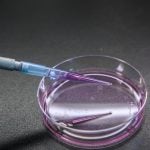TROCHU, Alta. – If flowing water arrived in the Special Areas of southeastern Alberta, it could bring renewed hope to an arid place where the population is nearly as sparse as rainfall.
A project to divert water from the Red Deer River has been discussed for decades, but Jay Slemp believes it may actually start to happen soon providing supporters can convince the province to foot the bill.
A $200 million proposal to the province would see a pump diversion system on the Red Deer River to send water through 423 kilometres of canals and existing streams at the rate of seven cubic metres per second, said Slemp, chair of the Special Areas board that covers about five million acres of dryland farming and grazing.
Read Also

Bio-fumigation may become new use for mustard
Mustard is great on hot dogs, but innovators in Western Canada have developed a new mustard variety for a different market — bio-fumigation.
The Special Areas water project could improve about 60,000 acres, with most of the water used for livestock and some irrigation.
“Guys are more interested in stock water than irrigation,” said Slemp following a water meeting in Trochu, north of Calgary.
“But there are benefits to irrigate and reduced feed costs.”
Two off-stream reservoirs at Lehman and Oyen, Alta., are included in the proposal.
The project is supported by nearby Stettler and Paint Earth counties, and has already applied for a water licence to take an average of 53,440 cubic decameters per year from the river. About 18 percent of the Red Deer River is allocated. This project would take another four percent of the water.
Proponents are taking the presentation to the standing policy committee of Alberta Environment with a refined design and studies outlining building and operating costs.
If the government agrees to pay a large share of the cost, the next steps are an environmental assessment, more public consultation and some regulatory changes.
The area has proven to be rich in oil and gas but the revenues generate little local investment.
“The oil might disappear but what we want to do is have something (that) is renewable and sustainable and I think agriculture is a good place to invest,” Slemp said.
With a guaranteed water supply, the area could introduce some intensive livestock operations where the manure would be welcome on the dry, sandy soils.
Between 1991-2001, Alberta’s population grew by 17 percent while this area experienced a five percent decline and is now around 12,000 people.
The biggest opposition has come from the City of Red Deer. Slemp said the City would not be affected by the amount of water needed for this project. He pointed out the Bow River basin is fully allocated yet economic development and growth in the area has grown exponentially and supports about one million people.















